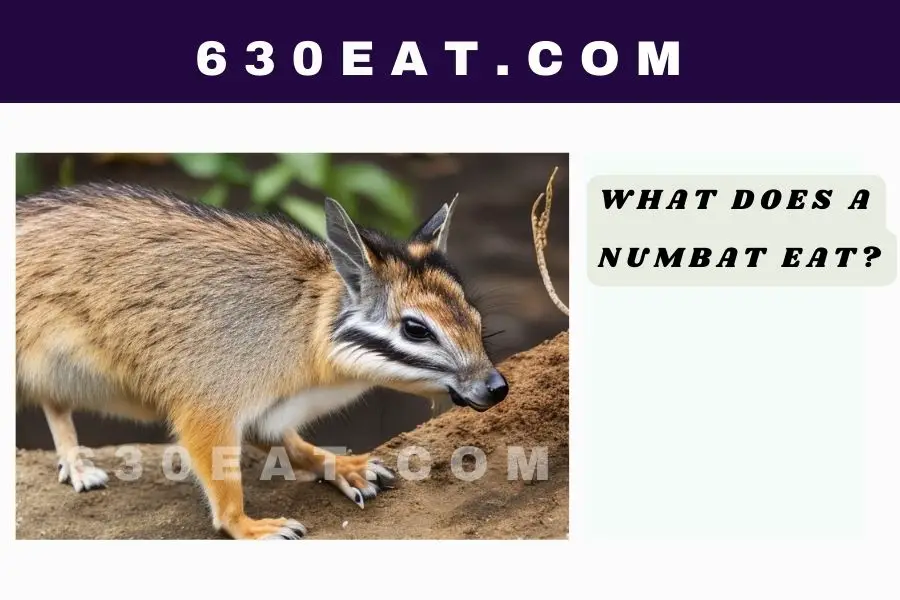Numbat, also known as the banded anteater or the marsupial anteater, is a small, diurnal marsupial that is native to Western Australia. The unique physical features of this creature make it easily distinguishable from other marsupials, but what sets it apart the most is its diet. Numbats are insectivores, which means their diet is mainly composed of insects.
In this article, we will delve deeper into the numbat’s diet, foraging techniques, habitat, and distribution, as well as the threats it faces and the conservation efforts being made to preserve this unique marsupial.
The Diet of Numbat
The numbat’s diet consists mainly of termites and ants. These insects provide the numbat with a rich source of protein, which is essential for its survival. Numbats have a long, thin tongue that can extend up to 10 centimeters, which they use to capture insects. They have strong jaws and teeth that help them crush the exoskeleton of insects, making it easier for them to digest.
Insects
Termites
Termites are the primary source of food for numbats, accounting for up to 80% of their diet. Numbats feed on termites of the genera Mastotermes, Nasutitermes, and Microcerotermes, among others. They use their sense of smell to locate termite mounds, which they dig into using their strong forelimbs and sharp claws.
Ants
Numbats also feed on ants, although they are not as abundant as termites. They mainly feed on the larvae of the meat ant and sugar ant. Numbats use their long tongue to reach into the ant’s nest and capture the larvae.
Importance of Insects in Numbat’s Diet
Insects are an essential source of protein for numbats, providing them with the necessary nutrients to maintain their metabolism and energy levels. Insects are also low in fat, making them an ideal food source for the numbat, which has a high metabolism.
Consumption Rate of Insects
Numbats are voracious eaters, and they consume many insects each day. It is estimated that a single numbat can consume up to 20,000 termites in a single day. This high consumption rate is necessary for the numbat to meet its energy requirements.
Numbat’s Foraging Techniques
Diurnal Nature
Numbats are diurnal creatures, which means they are active during the day and rest at night. They spend most of their day foraging for food and can cover up to 1.5 kilometers in search of food.
Foraging Methods
Active Hunting
Numbats are active hunters and will move through the forest floor searching for prey. They use their keen sense of smell to locate termite mounds and ant nests and dig into them using their strong forelimbs and sharp claws.
Termite Mounds
Numbats mainly feed on termites and use their strong sense of smell to locate termite mounds. They dig into the mound using their strong forelimbs and sharp claws and use their long, thin tongue to capture the insects.
Hollow Logs
Numbats also forage in hollow logs, which provide a safe refuge for termites. They use their sharp claws to rip open the logs and use their sense of smell to locate the termites.
Habitat and Distribution
Natural Habitat
Numbats are native to Western Australia and are found in a variety of habitats, including eucalyptus woodlands, heathlands, and shrublands. They prefer areas with a high density of termite mounds and ant nests.
Geographical Distribution
Numbats are endemic to Western Australia and are only found in a few locations, including Dryandra Woodland, Perup Nature Reserve, and Boyagin Nature Reserve.
Threats to Numbat’s Diet
Habitat Loss
Habitat loss is one of the major threats to the numbat’s diet. The conversion of land for agriculture, logging, and urbanization has led to a significant reduction in the numbat’s habitat, making it harder for them to find food.
Introduced Predators
Introduced predators, such as foxes and feral cats, pose a significant threat to the numbat’s diet. These predators prey on numbats, reducing their population size and making it harder for them to find food.
Climate Change
Climate change is also a threat to the numbat’s diet. Changes in temperature and rainfall patterns can affect the distribution and abundance of insects, making it harder for numbats to find food.
Conservation of Numbat
Conservation Efforts
Conservation efforts for the numbat are focused on habitat restoration and predator control. The Western Australian government has established several reserves to protect the numbat’s habitat, and predator control programs have been implemented to reduce the impact of introduced predators on the numbat population.
Role of Zoos
Zoos also play an important role in the conservation of numbats. Zoos breed numbats in captivity and release them into the wild, helping to increase the numbat population and preserve this unique marsupial.
Conclusion
Numbats are unique marsupials with a highly specialized diet of insects, mainly termites and ants. Their foraging techniques and habitat preferences make them highly adapted to their environment, but they are facing several threats, including habitat loss, introduced predators, and climate change. Conservation efforts, including habitat restoration and predator control, are necessary to preserve the numbat population and ensure their survival.
FAQs
How many numbats are left in the wild?
There are approximately 1,000 to 1,500 numbats left in the wild.
How long can a numbat survive without food?
Numbats can survive for up to 24 hours without food.
What is the lifespan of a numbat?
The average lifespan of a numbat is around 5-7 years in the wild.
Can numbats be kept as pets?
No, numbats are protected under the Western Australian Wildlife Conservation Act, and it is illegal to keep them as pets.
Are numbats related to anteaters?
No, numbats are not related to anteaters. They belong to the family Myrmecobiidae, which means “ant-eating marsupials,” but they are not closely related to anteaters, which are found in South America.
How do numbats digest their food?
Numbats have a specialized digestive system that allows them to digest the tough exoskeleton of termites and ants. They have a gizzard-like stomach that grinds up the insects, and bacteria in their gut help break down the cellulose in the exoskeleton.
Are numbats nocturnal?
No, numbats are diurnal, which means they are active during the day and sleep at night. They are most active during the early morning and late afternoon, when the temperature is cooler and the insects are more active.
Can numbats swim?
Numbats are not strong swimmers and generally avoid water. They are adapted to living in dry, arid environments and are more comfortable on land.
How can I help conserve numbats?
You can help conserve numbats by supporting conservation organizations that work to protect their habitat and reduce the impact of introduced predators. You can also reduce your impact on the environment by using environmentally-friendly products and reducing your carbon footprint.
What other animals rely on termites for food?
Other animals that rely on termites for food include aardvarks, anteaters, pangolins, and several species of birds and reptiles. Termites play an important role in many ecosystems, providing a valuable source of food for a wide variety of species.




